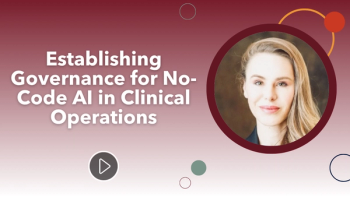
Standardizing Site Clinical Trial Management with the eISF Reference Model
Clinical research sites feel growing pressure to perform work in a compliant manner while keeping pace with stakeholder information exchange workstreams, but lack the consistent processes to do so.
Clinical trials, and in turn, regulatory documentation, have become increasingly complex over the last 10 years. Clinical research sites conducting trials feel growing pressure to perform work in a compliant manner while keeping pace with stakeholder information exchange workstreams. Traditionally, performance in these areas suffered due to lack of consistent processes across study documentation lifecycles and research sites' portfolios of stakeholders.
Unlike sponsors and CROs that refer to a standard trial master file (TMF) reference model, sites have historically experienced neglect when it comes to universally driven digital artifiact standardization practices. As a result, research organizations are now demanding collaborative thought leadership to solve this inefficiency problem. The outcome of these efforts will empower sites to better manage trials and create an intuitive documentation outline to increase productivity over time to the benefit of all vested parties.
Enter the eISF Reference Model, built in collaboration with MAGI. The Electronic Investigator Site File (eISF) Reference Model is a standardized outline that guides sites on how to digitally organize and categorize clinical trial documentation to map directly from site technology to sponsor technology. This documentation includes regulatory files, third-party contracts, vendor contracts, investigator agreements, financial documentation, staff credentials, IRB documentation, protocols, study subject information, and all other documentation needed to manage a clinical trial.
This advancement allows for sites to more easily move from antiquated paper regulatory binders to a robust digital eRegulatory platform. It also allows sites already using an eRegulatory platform to create repeatable processes to manage trials-and information exchange demands-more efficiently.
Over the past 18-plus months, MAGI led the charge to cooperate with industry thought leaders on the formation of the eISF Reference Model.
The steering committee included thought leaders, researchers, and solution providers such as Florence Healthcare, WCG, Complion, Realtime, MasterControl, Advarra, ICON, INC Research, LMK Research, Meridien Research, OHSU, PRA, Seattle Cancer Care Alliance, University of Pennsylvania, University of Washington, and Vanderbilt University, among others.
The eISF Reference Model is the industry standard for electronically managing clinical research site documentation and is the first of its kind to blend practical knowledge with innovation practices for future needs.
To accomplish this, the eISF Reference Model strategically built a committee of three main industry influencers: leading clinical research sites, industry technology vendors, and sponsor and CROs.
This committee worked to pioneer a guide that answers both trial documentation management needs and the call for keeping pace with ever-advancing research.
Each participating leader of this committee represented a core consideration for the industry at large:
- Research sites (which made up the bulk of the committee) offered an unparalleled understanding of their own challenges and needs.
- Technology vendors, such as Florence, brought a deep understanding of the intricacies of technology, the limitations of current methods and modernization best practices such as system integration needs.
- Sponsors and CROs provided important balance and perspectives as to what is needed for TMF completeness and successful monitoring to ensure there are no stop-gaps in advancing research.
As a result, the eISF Reference Model was built by sites and for sites, with two main goals in mind.
First, was to allow new Sstes to have a solid foundation for building regulatory binders to manage trials efficiently-allowing more sites to run and participate in trials. Increasing site participation in trials creates higher opportunities for patient recruitment, diversified patient population, and accessibility to treatments.
Second, was to enable sites to grow their study volume more quickly in a standardized way. With this model applied, each study benefits from a similar structure, which aids in reduced study start-up tasks, advanced project timelines, and a successful transition during coordinator turnover.
To facilitate new research site growth and the expansion of current site study profiles, the MAGI eISF Reference Model Committee focused on standardization and streamlining sponsor/site communication.
Due to the thoughtful analysis of the site trial experience, the eISF Reference Model was built to follow the natural flow throughout the life of the study. Sites involved in the committee were able to prioritize elements of a typical study to ensure that this model was reflective of real-world and day-to-day functions. In addition, sites provided feedback during the peer review process to assure the sample size was expanded beyond the original committee.
The model reflects these discussions and moves smoothly through study start-up, conduct, monitoring, and closeout to include all pertinent documents. As each site may have unique internal document nomenclature, this model identifies the most common and practical document naming conventions.
Each section of the eISF Reference Model is systematically organized into intuitive categories with references to where documents map to the TMF reference model built for sponsors. Specifications that allow direct mapping from site systems to sponsor systems, create more transparent communication, and reduce friction points that delay study timelines.
A collaborative approach spearheaded by MAGI creates a conducive and all-encompassing perspective of the most suitable model to manage electronic investigator site file documentation.
As a reference model, sites are not required to adopt this outline but are encouraged to investigate if the eISF Reference Model better serves their site's unique organizational goals.
For sites looking to advance their study profiles proactively, this model is a great jumping-off point to launch into successful growth and stronger relationships with sponsors.
The model can be downloaded
Jordan Tapley, Senior Solutions Engineer at Florence Healthcare, and MAGI eISF Reference Model Committee Chair; email: jordan.tapley@florencehc.com
Newsletter
Stay current in clinical research with Applied Clinical Trials, providing expert insights, regulatory updates, and practical strategies for successful clinical trial design and execution.






.png)



.png)



.png)
.png)
